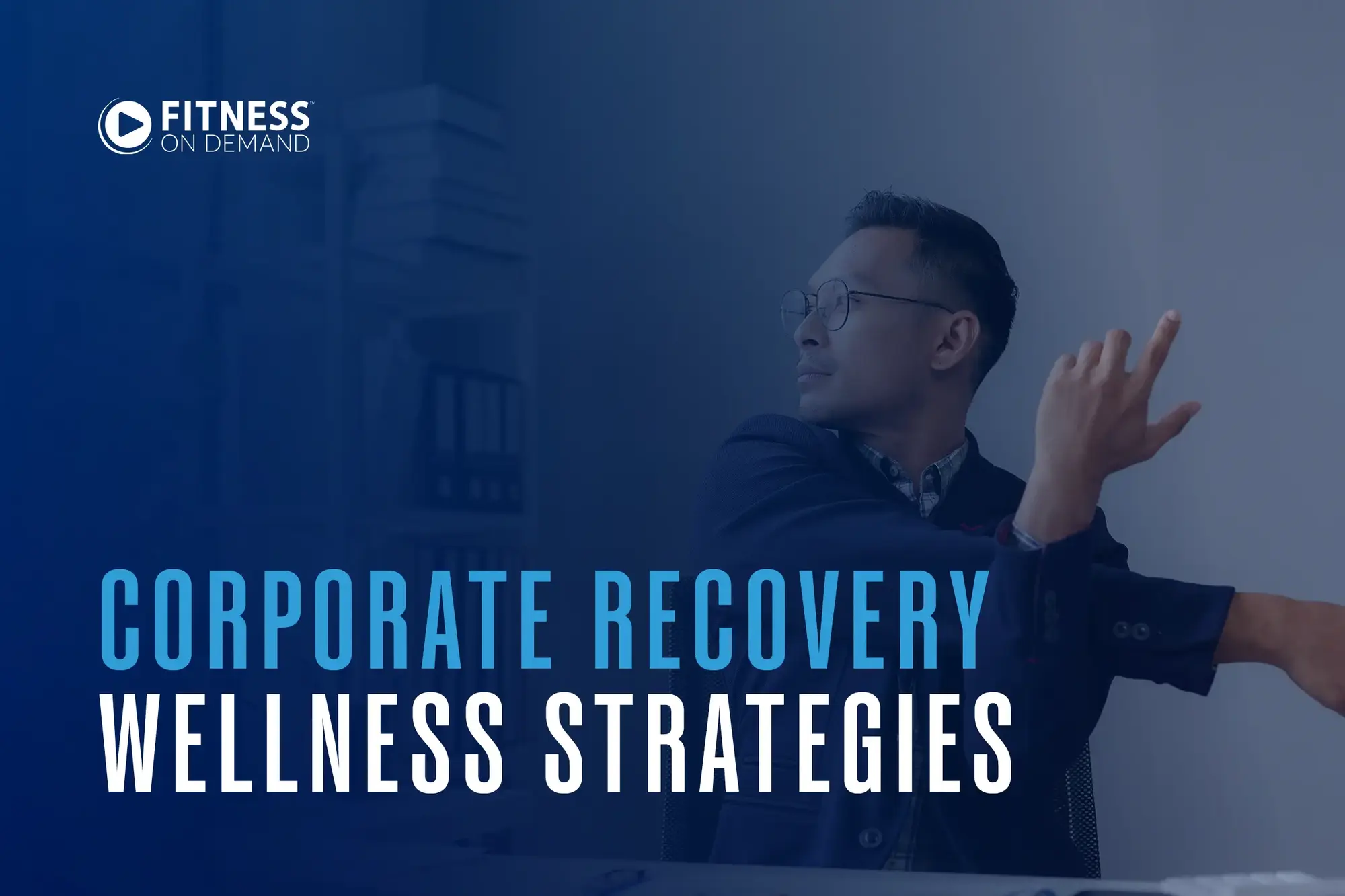More and more companies are recognizing that true success goes beyond financial performance. It also depends on how well organizations support and care for their employees.

Traditional corporate wellness programs once focused almost entirely on gym memberships, step challenges, or nutrition workshops. Although these remain important, organizations now understand that without proper recovery, even the best wellness initiatives can fall short.
Recovery is the missing piece that connects physical performance, mental health, and long-term resilience. It addresses stress, boosts energy, and allows employees to show up as their best selves every day. For HR leaders and wellness coordinators, integrating recovery-focused practices into workplace wellness strategies can transform both culture and performance.

What Is Corporate Wellness?
This article highlights why recovery matters, what strategies companies can use, and how digital innovations like the recovery touchscreen help make these programs accessible, scalable, and engaging. It also provides answers to common questions while offering best practices for building sustainable wellness goals across organizations.
Why Recovery Is Central to Corporate Wellness
Wellness once meant hitting the gym or eating more vegetables, but today’s employees need much more. Stress, burnout, and fatigue have become common challenges in the workplace. According to a 2023 survey from the American Psychological Association, more than half of the employees found that work-related stress negatively impacted their productivity. That’s why modern workplace wellness strategies are slowly shifting to focus not just on effort but also on recovery.
Recovery provides the foundation for consistent performance. Without adequate downtime, employees face a cycle of stress accumulation that impacts both their health and the company’s bottom line. Programs that include mental health support, relaxation techniques, and emotional wellness activities empower teams to stay resilient in the face of daily pressures.
For organizations, recovery-driven wellness strategies translate into tangible business benefits such as reduced absenteeism, lower turnover, and higher productivity. Embedding recovery into wellness programming allows companies to demonstrate their commitment to employee health in a way that goes beyond surface-level perks.
Core Elements of Recovery-Focused Wellness Strategies
Recovery is multidimensional. To build effective workplace wellness strategies, companies should focus on several aspects, including physical recovery, mental recovery, emotional recovery, and lifestyle recovery. Let’s explore each of these dimensions in greater detail for the better implementation of wellness strategies.
Physical Recovery
Employees often spend hours sitting, which can lead to stiffness, pain, and reduced energy. Corporate wellness programs can combat this by:
- Offering guided stretching and mobility sessions to prevent musculoskeletal strain
- Including light yoga or restorative fitness classes that improve posture and circulation
- Creating spaces in on-site fitness centers where employees can use foam rollers, massage chairs, or stretching mats
Mental Recovery
Supporting mental health is just as critical as supporting physical well-being. Employees benefit when organizations provide:
- Mindfulness and meditation sessions that improve focus and reduce stress
- Breathing and relaxation techniques to lower anxiety during high-pressure periods
- Programs that link behavioral health and resilience to workplace demands
Emotional Recovery
Employees face daily pressures that can affect mood, motivation, and overall engagement. Companies can support emotional recovery by:
- Offering workshops or on-demand sessions on stress management, coping skills, and emotional regulation
- Creating peer support networks or mentorship programs that foster connection and a sense of belonging
- Encouraging open communication about mental health to reinforce that seeking support is a strength and not a weakness
Lifestyle Recovery
Long-term wellness is influenced by daily habits outside the office. Companies can help employees make better choices by:
- Promoting a balanced diet with nutrition education or healthier cafeteria offerings
- Launching hydration challenges or providing access to filtered water stations
- Supporting health coaching that emphasizes sleep hygiene, hydration, and sustainable nutrition
Here’s a quick FAQ to summarize what we’ve learned so far.
What are the 5 strategies to promote well-being?
Employee well-being is like a recipe with five essential ingredients. If even one is missing, the dish simply won’t be as satisfying. Similarly, the five core wellness strategies that create a thriving workplace are:
- Stress management: It focuses on mental health and behavioral health through relaxation techniques and mindfulness practices.
- Active living: This keeps employees moving with fitness classes, walking meetings, or access to a fitness center.
- Balanced nutrition: It encourages healthier choices and a well-rounded yet healthy, balanced diet.
- Recovery routines: These highlight the importance of sleep, hydration, and downtime for resilience.
- Community connection: Finally, this builds emotional wellness by fostering support networks and shared wellness goals.
Together, these strategies strengthen employee health and enhance workplace wellness.
Implementing Recovery Strategies in Businesses
Understanding recovery is one thing, but making it part of the workday is another. Many companies hesitate because they fear disrupting productivity. In reality, recovery strategies can be built seamlessly into routines. Here are some simple ideas to help you get started.
Micro-breaks
Encourage employees to take five-minute stretch or breathing breaks every hour. Digital prompts or break-room signage can make this effortless.
Wellness amenities
On-site fitness centers can designate recovery zones with guided relaxation techniques or mobility equipment. For smaller companies, offering digital access to fitness classes provides the same benefits.
Scheduled programming
Midday yoga, walking meetings, or guided meditation sessions build recovery directly into the workday without requiring significant time commitments.
Remote access
For hybrid or remote teams, digital platforms and the recovery touchscreen provide recovery programming accessible from any location.
Modern employees don't view wellness as a side perk but as a part of their daily work life. Supporting recovery shows that the company values its people beyond productivity, which boosts morale and engagement.
Future of Corporate Wellness and Recovery
The next phase of corporate wellness is all about integration and personalization. Instead of offering stand-alone programs, companies can weave recovery practices into broader health and productivity strategies.
Hybrid delivery models are becoming standard. This allows employees to attend in-person fitness classes or mindfulness workshops while also accessing digital apps from home. Additionally, personalized recovery programs are on the rise as they adapt to individual needs, ranging from stress reduction plans to tailored health coaching.
Thus, preventative care is taking center stage, with a focus on behavioral health, emotional wellness, and balanced diet education to eliminate issues before they affect productivity. Wellness goals are increasingly being integrated into performance reviews, reinforcing that recovery is a vital part of long-term talent development.
For forward-thinking leaders, embracing recovery is the competitive edge that keeps employees engaged and thriving.
Digital Tools Supporting Recovery and Wellness
Technology has redefined how companies approach workplace wellness strategies. Instead of relying only on in-person programs, digital platforms now make recovery accessible to all employees. Consider the following examples.
- On-demand recovery classes deliver stretching, yoga, and mindfulness content instantly, thereby reducing barriers to participation.
- The recovery touchscreen brings interactivity to corporate spaces. This allows employees to access guided programs directly in break rooms, lobbies, or fitness centers.
- Analytics and reporting tools help HR leaders measure engagement, refine wellness programming, and demonstrate return on investment (ROI) to executives.
Digital platforms also promote inclusivity. Remote employees, parents balancing family responsibilities, or staff with unconventional schedules can still access wellness programming. This guarantees that recovery isn’t just for a few employees. Rather, it’s embedded in the fabric of the organization.
Frequently Asked Questions About Recovery Wellness Strategies
What is recovery and wellness?
Recovery and wellness refer to the integration of rest, resilience, and balance across the physical, mental, and emotional dimensions of health. In a corporate setting, it means offering tools for mental health, behavioral health, emotional wellness, and lifestyle support alongside fitness and nutrition.
What is a recovery wellness plan?
A recovery wellness plan is a structured approach to supporting employee health with wellness strategies like stretching sessions, meditation breaks, hydration campaigns, and health coaching. It creates consistency and accountability across the workplace.
What are the 4 types of recovery?
The four main types of recovery are:
- Physical recovery includes mobility, stretching, and rest.
- Mental recovery involves stress management and mindfulness.
- Emotional recovery covers resilience training, connection, and emotional wellness.
- Lifestyle recovery includes nutrition, hydration, and sleep routines to support a balanced diet and long-term health.
Why is it important to ask for help in recovery?
Recovery is more successful with community support and adequate resources. Access to fitness classes, health coaching, and digital recovery tools makes it easier for employees to stay consistent while also fostering a sense of connection.
Fitness On Demand’s Role in Wellness Strategies
For organizations looking to integrate recovery and holistic wellness seamlessly, Fitness On Demand offers flexible solutions designed for modern workplaces. Our recovery touchscreen delivers instant access to guided mobility, stretching, and mindfulness classes. This allows employees to reset during the workday.
Our tools complement existing workplace wellness strategies by providing content that supports mental health, emotional wellness, behavioral health, and physical recovery. Whether employees prefer short stretch breaks or structured fitness classes, the platform adapts to diverse needs.
With customizable options, companies can tailor programs to align with employee wellness goals and scale solutions across offices or remote teams. By focusing on both effort and recovery, businesses can foster cultures where employees thrive.
Discover how to bring these recovery-focused solutions to your workplace with the Fitness On Demand Recovery Touchscreen.

Author
Sean Obregon
Sean Obregon is an impactful Business Development Executive forming meaningful relationships to support enhancing operational and strategic success. He utilizes his industry knowledge and experience to create solutions that align with both the needs and wants of a customer, setting a business up for success.
